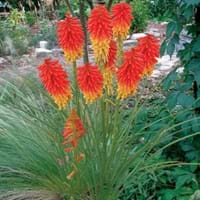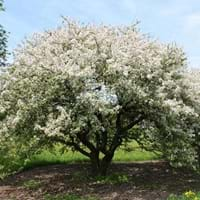Life Span
Perennial
Perennial
Origin
Hybrid origin
Eastern Asia, Japan
Types
Not Available
Not Available
Habitat
Damp Places, Marshy ground
Not Available
USDA Hardiness Zone
6-9
4-8
Sunset Zone
2a, 2b, 3a, 3b, 4, 5, 6, 7, 8, 9, 14, 15, 16, 17, 18, 19, 20, 21, 22, 23, 24
A3, 1a, 1b, 2a, 2b, 3a, 3b, 4, 5, 6, 7, 8, 9, 10, 14, 15, 16, 17, 18, 19, 20, 21
Habit
Clump-Forming
Oval or Rounded
Flower Color
Yellow, Red, Orange, Pink
Not Available
Flower Color Modifier
Bicolor
Bicolor
Fruit Color
Not Available
Red, Yellow
Leaf Color in Spring
Green, Blue Green
Not Available
Leaf Color in Summer
Green, Blue Green
Not Available
Leaf Color in Fall
Blue Green, Gray Green, Light Yellow
Not Available
Leaf Color in Winter
Light Green
Not Available
Plant Season
Spring, Summer
Spring
Sunlight
Full Sun, Partial Sun
Full Sun
Growth Rate
Medium
Medium
Type of Soil
Clay, Loam, Sand
Clay, Loam, Sand
The pH of Soil
Acidic, Neutral
Acidic, Neutral, Alkaline
Soil Drainage
Well drained
Well drained
Bloom Time
Early Summer, Summer
Spring, Late Spring
Tolerances
Drought
Not Available
Where to Plant?
Container, Ground
Ground
How to Plant?
Divison, Seedlings
Divison
Plant Maintenance
Medium
Medium
Watering Requirements
Needs more water during establishment, Water Deeply, Water in morning to avoid prompting diseases, Water in the early morning hours
Do not water excessively
In Summer
Lots of watering
Lots of watering
In Spring
Moderate
Moderate
In Winter
Average Water
Average Water
Soil pH
Acidic, Neutral
Acidic, Neutral, Alkaline
Soil Type
Clay, Loam, Sand
Clay, Loam, Sand
Soil Drainage Capacity
Well drained
Well drained
Sun Exposure
Full Sun, Partial Sun
Full Sun
Pruning
Cut or pinch the stems, Remove damaged leaves, Remove dead branches, Remove dead leaves
Prune in spring, Requires very little pruning
Fertilizers
All-Purpose Liquid Fertilizer, Apply N-P-K
Doesn't require fertilization when grown in rich soil
Pests and Diseases
Onion thrips, Red blotch, Root rot
Healthy tree, Red blotch
Plant Tolerance
Drought, Moisture
Drought
Flower Petal Number
Single
Not Available
Foliage Texture
Coarse
Not Available
Foliage Sheen
Matte
Not Available
Attracts
Snails
Not Available
Allergy
Not Available
Poisonous
Aesthetic Uses
Borders, Cottage Garden, Ground Cover
Showy Purposes
Beauty Benefits
Not Available
Not Available
Environmental Uses
Air purification
Not Available
Medicinal Uses
Not Available
Not Available
Part of Plant Used
Not Available
Whole plant
Other Uses
Not Available
Used as Ornamental plant
Used As Indoor Plant
No
No
Used As Outdoor Plant
Yes
Yes
Garden Design
Container, Cutflower, Mixed Border, Rock Garden, Wall
Feature Plant, Shade Trees, Street Trees, Topiary / Bonsai / Espalier
Botanical Name
KNIPHOFIA 'Border Ballet'
Malus floribunda
Common Name
Tritoma, Wisley Blue Spring Starflower, Wisley Blue Springstar
Japanese flowering crabapple, Japanese crab, purple chokeberry, showy crabapple
In Hindi
Tritoma
Japanese crab apple
In German
Tritoma
Japanische Wildapfel
In French
Tritoma
Pommier du Japon
In Spanish
tritoma
Manzano silvestre japonés
In Greek
tritoma
Ιαπωνικά μήλο καβουριών
In Portuguese
Tritoma
maçã de caranguejo japonês
In Polish
Tritoma
Japoński krab jabłko
In Latin
Trytoma
Japanese crab apple
Phylum
Tracheophyta
Magnoliophyta
Class
Magnoliopsida
Magnoliopsida
Order
Asparagales
Rosales
Family
Liliaceae
Rosaceae
Clade
Angiosperms, Monocots
Angiosperms, Eudicots, Rosids
Tribe
Not Available
Maleae
Subfamily
Not Available
Amygdaloideae
Importance of Tritoma and Japanese Crab Apple
Want to have the most appropriate plant for your garden? You might want to know the importance of Tritoma and Japanese Crab Apple. Basically, these two plants vary in many aspects. Compare Tritoma and Japanese Crab Apple as they differ in many characteristics such as their life, care, benefits, facts, etc. Every gardener must at least have the slightest clue about the plants he wants to plant in his garden. Compare their benefits, which differ in many ways like facts and uses. The medicinal use of Tritoma is Not Available whereas of Japanese Crab Apple is Not Available. Tritoma has beauty benefits as follows: Not Available while Japanese Crab Apple has beauty benefits as follows: Not Available.
Compare Facts of Tritoma vs Japanese Crab Apple
How to choose the best garden plant for your garden depending upon its facts? Here garden plant comparison will help you to solve this query. Compare the facts of Tritoma vs Japanese Crab Apple and know which one to choose. As garden plants have benefits and other uses, allergy is also a major drawback of plants for some people. Allergic reactions of Tritoma are Not Available whereas of Japanese Crab Apple have Poisonous respectively. Having a fruit bearing plant in your garden can be a plus point of your garden. Tritoma has no showy fruits and Japanese Crab Apple has no showy fruits. Also Tritoma is flowering and Japanese Crab Apple is flowering. You can compare Tritoma and Japanese Crab Apple facts and facts of other plants too.





